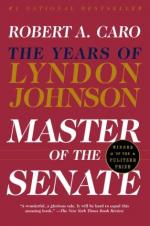|
This section contains 279 words (approx. 1 page at 400 words per page) |

|
Master of the Senate: The Years of Lyndon Johnson Summary & Study Guide Description
Master of the Senate: The Years of Lyndon Johnson Summary & Study Guide includes comprehensive information and analysis to help you understand the book. This study guide contains the following sections:
This detailed literature summary also contains Topics for Discussion and a Free Quiz on Master of the Senate: The Years of Lyndon Johnson by Robert Caro.
Master of the Senate is the third volume in Robert Caro's biography of Lyndon Baines Johnson, (1908 -1973), who peferred to be known as LBJ, because only great presidents were known by their initials. This volume covers the twelve years (1949-1960) that LBJ spent in the U.S. Senate, representing his native Texas, after having served several terms in the House of Representatives. It inevitably looks back to those earlier years and less often, ahead to his vice presidency under John F. Kennedy and his own presidency, marked by passage of the epochal Civil Rights Acts of 1964 and 1965.
Master of the Senate is also a study of how legislative power works in America and how Johnson mastered the Senate as no political leader had before him. Caro describes the ups and downs of Senate history, particularly in relation to the power of the Executive Branch, showing that in 1949 it was a tradition-rich, decentralized, inefficient body. He examines how LBJ carefully studied the institution in order to make himself useful to his colleagues and then turn this usefulness into a means of attaining his short-term goal of wielding real power somewhere (the House had not afforded this). Solidarity with the powerful "Southern Bloc" of senators was invaluable in this process, but because LBJ's ultimate goal was the presidency, he could not afford to be seen as merely a regional candidate, particularly a region whose primary goal was to resist granting civil rights to its black population. Much of the book deals with LBJ building national fame and maneuvering to balance all the conflicting forces that made it doubtful that he would ever sit in the Oval Office.
Read more from the Study Guide
|
This section contains 279 words (approx. 1 page at 400 words per page) |

|



